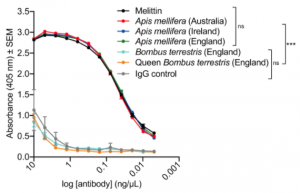24 3.3 Honeybee Venom and Melittin Reduce Breast Cancer Viability
Overview
This chapter will examine both honeybee venom and melittin across different breast cancer subtypes and its effects on breast cancer cells. The following sections will focus on the methodologies used by the authors to show how honeybee venom and melittin reduced breast cancer cells’ viability.
Potency of Honeybee Venom and Melittin Across Different Breast Cancer Subtypes
Using both honeybee venom and melittin, the authors examined cell viability over 24 hours across different breast cancer subtypes (as listed in the methods section, i.e., chapter 3.2). The authors were able to identify that venom has a higher anticancer selectivity and higher potency in both TNBC (SUM159 and SUM149 cell lines) and HER2-enriched (MDA-MB-453 and SKBR3 cell lines) compared to normal cells (HDFa cell line), which had the lowest impact seen (Duffy et al., 2020). This result can be visualized by the graph below, which resembles the cell viability assay of different cell lines:

The authors also measured the inhibitory concentration (IC50) of venom and melittin across different breast cancer subtypes.
Method: What is IC50?
Below is a figure obtained from Duffy et al., 2020 showing a reduction in IC50 for both SUM159 and SKBR3 cell lines compared to the normal HDFa cell line.

These results are significant because it allows us to focus on specific cell lines of TNBC and HER2-enriched with the highest potency for honeybee venom and melittin.
Cell Viability of SUM159 and SKBR3 cell lines using Honeybees from Different Honeybee Populations in Ireland and England
The authors used the cell lines, SUM159 and SKBR3 because these cell lines had the highest potency as observed from the previous cell viability assay (Duffy et al., 2020). The figure below shows venom from honeybee populations in Ireland (left graph) and England (right graph) (Duffy et al., 2020). They observed a reduction in cell viability of SUM159 and SKBR3 cells compared to non-transformed HDFa cells (Duffy et al., 2020).

The authors also tested venom from bumblebees obtained in England and they observed that samples obtained from both the workers (left graph) and queens (right graph) portrayed minimal cell death in all breast cancer cell lines compared to honeybee venom. The figure below shows the cell viability of bumblebee venom across SUM159, SKBR3 and HDFa cell lines.

These results are significant because it indicates that honeybee venom is better able to reduce cell viability of the cell lines, SUM159 and SKBR3 compared to other bee products, such as bumblebee venom.
Melittin is the most Prominent Bioactive Anticancer Compound within all Venoms
As mentioned earlier, melittin is the active component in honeybee venom. However, the authors wanted to study the abundance and anticancer effects of melittin.
The authors first assess relative abundance of melittin through a mouse monoclonal antibody that recognizes melittin in honeybee and bumblebee venom samples via ELISA (Duffy et al., 2020). The figure below shows no significant difference across all of the honeybee samples obtained from various locations; however, melittin concentrations were significantly higher in honeybee samples compared to bumblebee venom and control (IgG) (Duffy et al., 2020).

The main research is to assess the anticancer effects of melittin. This experiment was executed by blocking experiments in vitro and later, exploiting anti-melittin antibody to rescue cell viability of SUM159 and HDFa cell lines (Duffy et al., 2020). They also treated the cells with a combination of increasing concentrations of anti-melittin antibody and honeybee venom or melittin (Duffy et al., 2020). From this, they measured cell viability of the cell lines and they found that cell viability was higher when the SUM159 and HDFa cell lines were blocked with anti-melittin antibody and exposed to either venom or melittin peptides (Duffy et al., 2020).

Overall, the main take-away from these results was to show that melittin is the most prominent bioactive compound in honeybee venom and possesses anti-cancer activities as well.
Key Takeaways
- Honeybee venom has a higher potency in SUM159 and SKBR3 cell lines
- Honeybee venom is better able to target TNBC and HER2-enriched breast cancer subtypes than other bee products, such as bumblebee venom
- Melittin is the most prominent bioactive compound in honeybee venom
- Melittin has anticancer effects on breast cancer subtypes
References
- Duffy C., Sorolla A., Wang E., Golden E., Woodward E., Davern K., Ho D., Johnstone E., Pfleger K., Redfern A., Iyer K. S., Baer B, & Blancafort P. (2020). Honeybee venom and melittin suppress growth factor receptor activation in HER2-enriched and triple-negative breast cancer. NPJ Precision Oncology, 4(24), 1-24. doi:10.1038/s41698-020-00129-0
